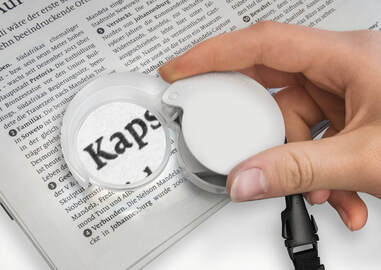Types of magnifier
If you are considering magnification as a result of sight-loss, Associated Optical ALWAYS recommends that you seek advice from an Optical Professional. All of our products are available through a network of UK opticians - a local practice to you can be found via our retailer network map
HAND MAGNIFIERS

Hand-held magnifiers are one of the most common types of magnifiers available and will be familiar to most people. Nearly everyone has used a hand-held magnifier at some point in time.
The hand-held magnifier typically has a handle that is attached to a lens through which the user will view an object – whether it is text or an image. Because the user has the ability to adjust the distance between the lens and the object, hand-held magnifiers can be operated with the user wearing either their distance glasses or reading glasses depending on preference.
Eschenbach offers a wide range of hand-held magnifiers from which to choose. We carry illuminated and non-illuminated hand-held magnifiers with a variety of lens geometries - including aspheric, aplanatic, biconvex, and the multi-ordered diffractive lens. These lenses are available in either a round or rectangular format.
When choosing a magnifier it is important to consider the tasks you are wanting the magnification for. A rectangular lens may be more suited to reading columns of print, whereas a round lens may be more suitable for viewing a map or a watch.
Always aim to purchase the lowest magnification power available that will give you the results you need. Typically the stronger the lens power, the smaller the lens diameter and greater the reduction in eye to lens and focal distance.
Eschenbach hand-held magnifiers are available in powers from 2x to 12.5x and available in both rectangular and round formats .
Lighting is another consideration when purchasing a magnifier. Most people over the age of 60 require 3x more light on a subject than that of somebody in their 20s. This is due to the natural ageing process of the eye and completely normal. The most commonly used illumination in hand-held magnifiers today is the 'light emitting diode' (LED). LEDs are incredibly efficient, providing the user of up to 50,000 hours service and up to 10x longer battery life. Several studies exploring the efficacy of different LED light temperatures on reading performance have been published in the last few years. All have come to the conclusion that light temperature is subjective and anyone considering the purchase of a magnifier should explore at least the 3 main light temperatures commonly available - 2700K, 4500K & 6500K - Eschenbach is the only manufacturer at time of writing this that offer all 3 lighting temperatures in one magnifier - mobilux
Due to the fact the end-user must hold the magnifier, hand-held magnifiers are ideal for short-term spotting tasks such as reading a medicine bottle, a menu, a watch, washing tags, or even an oven dial. Actually, any task where a near object will be viewed for a short period of time can be assisted with the use of a hand-held magnifier.
When reading for longer periods of time, consider using a stand magnifier, hands-free magnifier, or a digital magnifier.
The hand-held magnifier typically has a handle that is attached to a lens through which the user will view an object – whether it is text or an image. Because the user has the ability to adjust the distance between the lens and the object, hand-held magnifiers can be operated with the user wearing either their distance glasses or reading glasses depending on preference.
Eschenbach offers a wide range of hand-held magnifiers from which to choose. We carry illuminated and non-illuminated hand-held magnifiers with a variety of lens geometries - including aspheric, aplanatic, biconvex, and the multi-ordered diffractive lens. These lenses are available in either a round or rectangular format.
When choosing a magnifier it is important to consider the tasks you are wanting the magnification for. A rectangular lens may be more suited to reading columns of print, whereas a round lens may be more suitable for viewing a map or a watch.
Always aim to purchase the lowest magnification power available that will give you the results you need. Typically the stronger the lens power, the smaller the lens diameter and greater the reduction in eye to lens and focal distance.
Eschenbach hand-held magnifiers are available in powers from 2x to 12.5x and available in both rectangular and round formats .
Lighting is another consideration when purchasing a magnifier. Most people over the age of 60 require 3x more light on a subject than that of somebody in their 20s. This is due to the natural ageing process of the eye and completely normal. The most commonly used illumination in hand-held magnifiers today is the 'light emitting diode' (LED). LEDs are incredibly efficient, providing the user of up to 50,000 hours service and up to 10x longer battery life. Several studies exploring the efficacy of different LED light temperatures on reading performance have been published in the last few years. All have come to the conclusion that light temperature is subjective and anyone considering the purchase of a magnifier should explore at least the 3 main light temperatures commonly available - 2700K, 4500K & 6500K - Eschenbach is the only manufacturer at time of writing this that offer all 3 lighting temperatures in one magnifier - mobilux
Due to the fact the end-user must hold the magnifier, hand-held magnifiers are ideal for short-term spotting tasks such as reading a medicine bottle, a menu, a watch, washing tags, or even an oven dial. Actually, any task where a near object will be viewed for a short period of time can be assisted with the use of a hand-held magnifier.
When reading for longer periods of time, consider using a stand magnifier, hands-free magnifier, or a digital magnifier.
STAND MAGNIFIER

Reading for longer periods of time usually requires the use of a stand magnifier.
A stand magnifier is basically a plus lens mounted on legs that fix the distance from the lens to the object. They work based on the principles of angular and relative distance magnification.
Some of the magnification, the ‘enlargement ratio’ is provided by the lens based on its distance from the object to be viewed. The rest of the magnification is provided by the user via relative distance magnification or ‘holding things closer’. The closer the user holds a stand magnifier to the eye or glasses, the more magnification they will obtain as well as improvements to the field of view (FOV).
Years ago, stand magnifiers were available only in non-illuminated versions. Because they relied on ambient light to illuminate the object or text, the legs often cast shadows across the field of view. As a result, Eschenbach introduced the concept of a self-illuminating stand magnifier.
Eschenbach offers a wide selection of Stand Magnifiers to choose from. These include standard Head & Handle combinations (System Vario), Bar and Bright Field magnifiers (makroLUX) and 'open face' magnifiers such as scriboLUX. Stand magnifiers are available with or without illumination; the illumination options include LED, halogen and tungsten, although at the time of writing this LED has become the industry standard due to its efficiency and excellent performance.
What spectacles should I wear? Distance or reading glasses? Stand magnifiers from Eschenbach Optik have a focusing distance aE (distance of the eye to the virtual image) of 400mm meaning reading glasses should be worn to obtain the best image. At higher magnification powers this tends to be less important.
Things to consider when purchasing a stand magnifier - What task are you looking to undertake? Eschenbach System Vario is ideal for reading a book, newspaper or magazine. Eshenbach visoLUX + is great for looking at old photographs. Due to the open design, the Eschenbach scriboLUX provides excellent magnification for puzzles, crosswords and small writing tasks, such as signing cheques or filling in forms.
A stand magnifier is basically a plus lens mounted on legs that fix the distance from the lens to the object. They work based on the principles of angular and relative distance magnification.
Some of the magnification, the ‘enlargement ratio’ is provided by the lens based on its distance from the object to be viewed. The rest of the magnification is provided by the user via relative distance magnification or ‘holding things closer’. The closer the user holds a stand magnifier to the eye or glasses, the more magnification they will obtain as well as improvements to the field of view (FOV).
Years ago, stand magnifiers were available only in non-illuminated versions. Because they relied on ambient light to illuminate the object or text, the legs often cast shadows across the field of view. As a result, Eschenbach introduced the concept of a self-illuminating stand magnifier.
Eschenbach offers a wide selection of Stand Magnifiers to choose from. These include standard Head & Handle combinations (System Vario), Bar and Bright Field magnifiers (makroLUX) and 'open face' magnifiers such as scriboLUX. Stand magnifiers are available with or without illumination; the illumination options include LED, halogen and tungsten, although at the time of writing this LED has become the industry standard due to its efficiency and excellent performance.
What spectacles should I wear? Distance or reading glasses? Stand magnifiers from Eschenbach Optik have a focusing distance aE (distance of the eye to the virtual image) of 400mm meaning reading glasses should be worn to obtain the best image. At higher magnification powers this tends to be less important.
Things to consider when purchasing a stand magnifier - What task are you looking to undertake? Eschenbach System Vario is ideal for reading a book, newspaper or magazine. Eshenbach visoLUX + is great for looking at old photographs. Due to the open design, the Eschenbach scriboLUX provides excellent magnification for puzzles, crosswords and small writing tasks, such as signing cheques or filling in forms.
HANDS-FREE MAGNIFIERS

Hands-free magnification is an important category and may be required for a variety of reasons. The user may suffer from hand tremors or poor dexterity meaning a hand magnifier is difficult to use or the task requires both hands to be free, such as sewing or painting intricate models. Whatever the task, Associated Optical has a vast portfolio of hands-free magnification to assist.
What is a hands-free magnifier? There are 2 main types of hands-free magnifiers: spectacle magnifiers and spectacle mounted telescopes.
Spectacle magnifiers include hyperocular lenses, segments and buttons, multi-order diffractive lenses, compound lenses or lens systems and clip on solutions. The majority of these would be found in a clinical setting and as with ALL magnification required for sight-loss, dispensed by a qualified practitioner. However, for those seeking help with seeing small detail, Eschenbach's maxDETAIL or maxDETAIL clip could be considered. Jewellers have benefited from Eschenbach's Labo-Clip due to its hands free design and high magnification powers.
What is a hands-free magnifier? There are 2 main types of hands-free magnifiers: spectacle magnifiers and spectacle mounted telescopes.
Spectacle magnifiers include hyperocular lenses, segments and buttons, multi-order diffractive lenses, compound lenses or lens systems and clip on solutions. The majority of these would be found in a clinical setting and as with ALL magnification required for sight-loss, dispensed by a qualified practitioner. However, for those seeking help with seeing small detail, Eschenbach's maxDETAIL or maxDETAIL clip could be considered. Jewellers have benefited from Eschenbach's Labo-Clip due to its hands free design and high magnification powers.
DIGITAL MAGNIFIERS

Electronic Magnifiers, Digital Magnifiers, Video Magnifiers & CCTV systems are all terms to describe 'Electronic Vision Enhancement Systems (EVES)'.
What is EVES or DIGITAL Magnification?
A digital Magnifier is a device that captures and displays text or an object on a screen. The user can then adjust the size of the text or object and manipulate the image on the screen via controls on the device. Features may include enhanced contrast, reverse colour & false colour.
There are 2 main types of digital magnifier, the first to consider is a desktop digital magnifier (EVES) or CCTV system. Typically the device would be setup on a desk allowing the user to place a document under the HD camera. An image of this document would then be displayed on a screen allowing the user to view a magnified image of the text as we can see in this image of a student working with the Eschenbach VARIO XL. There are many benefits to be had from a desktop system, some of which are listed here: Large screen or monitor, monitor position affords a comfortable posture, mains powered (no need to charge) large working area under camera that allows the user to complete writing tasks such as form filling & many standard features such as colour and contrast manipulation.
The second is the Portable Vision Enhancement Systems (p-EVES). Portable digital magnifiers have been in existence for a number of years and with the advancement of technology offer the user many of the features of the desktop system with the added benefit of the user being able to take them to their school, University or place of work etc. Typically the screen sizes vary from 5" - 13", examples of these are the Eschenbach smartLUX, visoLUX HD and visoLUX XL FHD. All of these p-EVES have been designed with the user in mind offering features such as, contrast enhancement, colour manipulation, image capture and of course the ability to change the size of the text or image. The visoLUX HD and visoLUX DGITAL XL FHD also have 'dynamic line scrolling' (DLS) enabling the user to 'scroll' the text being viewed.
Many people ask the question, 'Digital Magnifier or Optical Magnifier'? This is the wrong way to look at these groups of assistive devices. You should consider whether you need a digital magnifier. Very often users that have visual acuity (VA) of better than 6/30 will find that text being magnified by a digital magnifier may be too large and would benefit more from an optical magnifier. What are the main tasks you will be using the magnifier for? Short spotting tasks would be more suited to a handheld or pocket magnifier due to the size and ease of use of the device. If you are reading in bed or a chair, then a digital device may be a consideration as they allow comfortable posture due to a variable eye to lens distance with a bright high contrast screen. Many users that benefit from a digital device also have a handheld or pocket magnifier in their toolbox.
If you would like to discuss any of the above magnification options, please contact a member of the Associated Optical Team on 01628 600410.
What is EVES or DIGITAL Magnification?
A digital Magnifier is a device that captures and displays text or an object on a screen. The user can then adjust the size of the text or object and manipulate the image on the screen via controls on the device. Features may include enhanced contrast, reverse colour & false colour.
There are 2 main types of digital magnifier, the first to consider is a desktop digital magnifier (EVES) or CCTV system. Typically the device would be setup on a desk allowing the user to place a document under the HD camera. An image of this document would then be displayed on a screen allowing the user to view a magnified image of the text as we can see in this image of a student working with the Eschenbach VARIO XL. There are many benefits to be had from a desktop system, some of which are listed here: Large screen or monitor, monitor position affords a comfortable posture, mains powered (no need to charge) large working area under camera that allows the user to complete writing tasks such as form filling & many standard features such as colour and contrast manipulation.
The second is the Portable Vision Enhancement Systems (p-EVES). Portable digital magnifiers have been in existence for a number of years and with the advancement of technology offer the user many of the features of the desktop system with the added benefit of the user being able to take them to their school, University or place of work etc. Typically the screen sizes vary from 5" - 13", examples of these are the Eschenbach smartLUX, visoLUX HD and visoLUX XL FHD. All of these p-EVES have been designed with the user in mind offering features such as, contrast enhancement, colour manipulation, image capture and of course the ability to change the size of the text or image. The visoLUX HD and visoLUX DGITAL XL FHD also have 'dynamic line scrolling' (DLS) enabling the user to 'scroll' the text being viewed.
Many people ask the question, 'Digital Magnifier or Optical Magnifier'? This is the wrong way to look at these groups of assistive devices. You should consider whether you need a digital magnifier. Very often users that have visual acuity (VA) of better than 6/30 will find that text being magnified by a digital magnifier may be too large and would benefit more from an optical magnifier. What are the main tasks you will be using the magnifier for? Short spotting tasks would be more suited to a handheld or pocket magnifier due to the size and ease of use of the device. If you are reading in bed or a chair, then a digital device may be a consideration as they allow comfortable posture due to a variable eye to lens distance with a bright high contrast screen. Many users that benefit from a digital device also have a handheld or pocket magnifier in their toolbox.
If you would like to discuss any of the above magnification options, please contact a member of the Associated Optical Team on 01628 600410.


